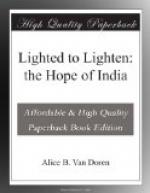In Madras you may visit a Widow’s Home, where through the wise efforts of a large-hearted woman in the Educational Department of Government more than a hundred Brahman girl-widows live the life of a normal schoolgirl. No fastings, no shaven heads, no lack of pretty clothes or jewels mark them off from the rest of womanhood. Schools and colleges open their doors and professional life as teacher or doctor offers hope of human contact and interest for these to whom husband and child and home are forever forbidden. In all India you may find a very few such institutions, but “what are these among so many?” The millions of repressed child widows still go on.
Wives of the Idol.
Worse is the fate of those whose Karma condemns them to a life of religious prostitution. Perhaps the first-born son of the family lies near to death. The parents vow a frantic vow to the deity of the local temple. “Save our son’s life, O Govinda; our youngest daughter shall be dedicated to thy service.” The son recovers, the vow must be fulfilled, and bright-eyed, laughing Lakshmi, aged eight, is led to the temple, put through the mockery of a ceremony of marriage to the black and misshapen image in the inmost shrine, and thenceforth trained to a religious service of nameless infamy.
The story of Hinduism holds the history of some devout seekers after God, of sincere aspiration, in some cases of beautiful thought and life. This deepest blot is acknowledged and condemned by its better members. Yet in countless temples, under the brightness of the Indian sun, the iniquity, protected by vested interests, goes on and no hand is lifted to stay. Suppose each American church to shelter its own house of prostitution, its forces recruited from the young girls of the congregation, their services at the disposal of its worshippers. The thought is too black for utterance; yet just so in the life of India has the service of the gods been prostituted to the lusts of men.
Reform.
The achievements of Christianity in India are not confined to the four million who constitute the community that have followed the new Way. Perhaps even greater has been the reaction it has excited in the ranks of Hinduism among those who would repudiate the name of Christian. Chief among the abuses of Hinduism to be attacked has been the traditional attitude toward woman. Child marriage and compulsory widowhood are condemned by every social reformer up and down the length of India. The battle is fought not only for women, but by them also. Agitation for the suffrage has been carried on in India’s chief cities. In Poona not long since the educated women of the city, Hindu, Muhammadan, and Christian, joined in a procession with banners, demanding compulsory education for girls.
Of women not Christian, but freed from ancient bonds by this reflex action of Christian thought, perhaps the most eminent example is Mrs. Sarojini Naidu. Of Brahman birth, but English education, she dared to resist the will of her family and the tradition of her caste and marry a man of less than Brahman extraction. Now as a writer of distinction second only to Tagore she is known to Europe as well as to India. In her own country she is perhaps loved best for her intense patriotism, and is the best known woman connected with the National Movement.




